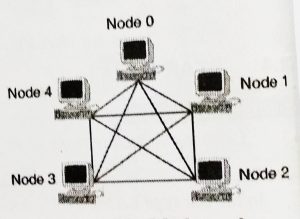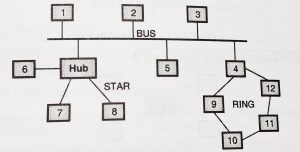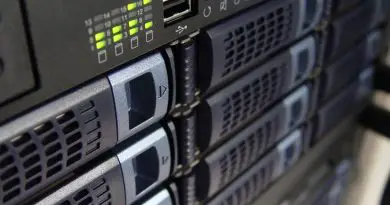Computer Network – Network Topology Types (Bus , Star , Mesh , Tree , Ring and Hybrid)
Howdy fellas!!
I hope you already went through my previous post by now. So , it is indeed clear that any communication network basically consists of nodes and links. And hence the term Network Topology is used to explain the manner in which any network is physically connected.
Nodes(or devices) are connected via communication links that are related to each other in one way or other. The geometric representation of such an interconnection of nodes and links is known as ‘Topology’ of that particular network.
These topologies can be divided mainly into two types:
Point to point(Line configuration/Line topology)
If one single line of the network is used by only two users , then it is called line topology. The link will be shared equally (sometimes also called peer to peer network).Addresses (of source and destination) are not required.
Also, no collision (due to overlapping of the message) will be present and hence no multiple access method(will be explained in my later posts) is required. For eg: Ring and Mesh topology.
Multi point (multi drop)
If one line is used by three or more users, line topology is called a multi-point network. Since one single line is used by many users, hence there is a requirement of separate source and destination address.
Also, there is a possibility of collision(message overlapping) will be there and to avoid such collision occurrences we need to implement some multiple access(MA) methods(like TDMA, FDMA, CDMA, CSMA, or carrier sense MA ).
Now let’s see the important network configuration(topology) types
Bus Topology
In a typical bus network, all the devices (nodes) are connected with a simple cable(no amplifier is present thus no amplification will be done).
When one computer sends a signal , all the other computers on the network will receive the information, however, only one computer with the address that matches with destination address stored in the message will accept the information while all other rejects the message.
In this topology, proper termination is required(to avoid any reflection of the transmitted wave), as without termination the signal reaches the end of the cable, it returns back and again travels back.
Thus there is a chance of creation of standing waves in the network, this can be avoided by terminating the bus on both ends by 50Ω load impedance(to absorb any reflection).

Ring Topology
In this topology, each node(computer) is connected to the next node(computer) in such a manner that the last node is connected to the first one .
Hence in this, the message can flow only in one direction.Also there is no termination because there is no end to the ring.In this, every device will re-transmits what it receives from the previous device.
In a typical ring network, all the nodes will be present along with an equal number of repeaters. The data will travel in a unidirectional sequential manner around the ring .
Each repeater will receive, regenerate, and re-transmit the data bit. Rings are used for high-performance networks where large bandwidth is necessary(such as audio and video).

Star Topology
You might already know about the primary-secondary network(one device controls the whole network). All the devices are connected via cable to a central location to a device called ‘Hub’. Hub is a networking device and using it, we can connect multiple devices .
The main function of the hub is to broadcast the received signal . Further hub is not able to read user addresses. Each device on a start network communicates with this central hub.The hub in a network can be of two types,i.e active and passive hub.
Active Hub : This hub generates the electrical signal and sends it to all the computers connected to it.It requires external power supply. It can regenerate the signal before splitting. Repeater is a two-port device and an active hub is a multiport device.
Passive hub : This hub will not be able to regenerate the received signal. Only voltage splitting is possible. It will not amplify the signal and thus no electrical power supply required.

-
Mesh Topology
In this network configuration, every device is physically connected to every other device with a point to point(dedicated) link.
A fully connected mesh network has n(n-1)/2 physical cables to connect ‘n’ devices.Every device on the network must have ‘n-1’ input/output ports.
It provides better privacy and security.Also failure of anyone device doesn’t bring down the entire network.Every message travels via a dedicated link and it makes fault diagnosis easy .

Tree Topology
This configuration is nothing but an extension(variation) of a star network.In this type also the nodes in the network connected to a central hub that controls the entire network..
However, each device is not connected to a central hub. Most of them are connected to a secondary hub which actually connected to a central hub.
The central hub contains repeater . The repeater amplifies the signal and increases the distance a signal can travel. The key advantage here is that many more devices can be attached to the central hub and hence increase the distance of a signal that can travel between devices. And the biggest drawback here is if the central hub fails then the system breaks down.

Logical Topology
This describes the manner in which the stations are logically connected for data unit exchange.For example, we can consider the bus topology.
The bus acts as a central controller. It receives data and forwards it to various nodes. Thus stations have a logical connection to the bus which acts as a centralized controller.Hence the logical topology of a bus is a star topology.
Hybrid Topology
In this type, we have a combination of two or more topologies together. There are different ways in which a hybrid network is created.
The hybrid configuration depends upon the particular application that depends on the requirements of that application. Many complex networks can be reduced to some form of hybrid topology.

See you soon in my next post with a more detailed explanation of other interesting topics in this field.

Aric is a tech enthusiast , who love to write about the tech related products and ‘How To’ blogs . IT Engineer by profession , right now working in the Automation field in a Software product company . The other hobbies includes singing , trekking and writing blogs .




